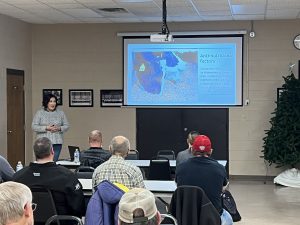Silage is one of the main ingredients in dairy cattle diets and is an important source of nutrients, particularly energy and digestible fiber. Much progress has been done allowing farmers to grow and harvest quality forages including plant genetics, optimum maturity, soil fertility, and storage facilities. However, this progress does no good if the feed is not harvested and stored cleanly, minimizing potential contamination that can be detrimental to the cow.
At the annual Fond du Lac County Forage Council & Extension Fond du Lac County Dairy-Forage Day, Dairy & Livestock Agent Tina Kohlman discussed with farmers, forage growers, agronomists, and dairy nutritionists the anti-nutritional factors in dairy forages: substances, which by themselves or through their metabolic products, interfere with feed utilization and affect the health and productivity of the cow. These factors, such as molds, mycotoxins, and bacterial contamination, can cause gut health issues leading to inconsistent manure consistency, disease, decreased milk quality, milk production, and immune system, and in some cases sudden death.
Molds grow on feed at the expense of proteins, fats, and carbohydrates leaving less for the cow to utilize, are less palatable and digestible leading to lower feed intake, lower milk production, and reduced income. Mycotoxins are metabolic byproducts of molds and cause the same issues as molds, but also reproductive dysfunction.
Bacterial contamination is lesser-known, but an important topic in the feed industry. The presence of pathogenic bacteria, such as Listeria, Bacillius spp., Clostridium spp., Salmonella, and enterobacteria (E. coli), can cause mild diarrhea and reduced feed intake, to reproductive disorders, and death. Contamination of pathogenic bacteria is usually due to contamination or poor forage management during fermentation, feeding out stage in silos and bunkers, manure contamination, or dirty feed bunks/alleys and equipment.
Feed hygiene is key in minimizing or removing the anti-nutritional factors in feed that can negatively affect animal health and performance. Key factors in reducing feed contamination include utilizing loader buckets dedicated to feed only, placing silage bags on surfaces to minimize soil contamination, properly face silage piles and bunks, reduce water runoff through silage piles, proper height of disc mowers, remove rodents and birds in feed storage and feed alleys, tarp hay, and maintain clean feed alleys.
For more information regarding feed management, please visit https://dairy.extension.wisc.edu/.





